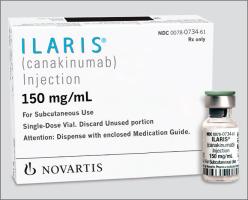Canakinumab Dosage
Medically reviewed by Drugs.com. Last updated on Aug 6, 2025.
Applies to the following strengths: 150 mg; 150 mg/mL
Usual Adult Dose for:
- Familial Cold Autoinflammatory Syndrome
- Muckle Wells Syndrome
- Cryopyrin-Associated Periodic Syndrome
- Familial Mediterranean Fever
- Hyperimmunoglobulin D Periodic Fever Syndrome
- Tumor Necrosis Factor Receptor Associated Periodic Fever Syndrome
- Still's Disease
- Gout
Usual Pediatric Dose for:
- Familial Cold Autoinflammatory Syndrome
- Muckle Wells Syndrome
- Cryopyrin-Associated Periodic Syndrome
- Familial Mediterranean Fever
- Hyperimmunoglobulin D Periodic Fever Syndrome
- Tumor Necrosis Factor Receptor Associated Periodic Fever Syndrome
- Juvenile Idiopathic Arthritis
Additional dosage information:
Usual Adult Dose for Familial Cold Autoinflammatory Syndrome
15 kg to less than or equal to 40 kg: 2 mg/kg to 3 mg/kg subcutaneously every 8 weeks
Greater than 40 kg: 150 mg subcutaneously every 8 weeks
Use: Cryopyrin-associated periodic syndromes (CAPS) including familial cold autoinflammatory syndrome (FCAS) and muckle-wells syndrome (MWS)
Usual Adult Dose for Muckle Wells Syndrome
15 kg to less than or equal to 40 kg: 2 mg/kg to 3 mg/kg subcutaneously every 8 weeks
Greater than 40 kg: 150 mg subcutaneously every 8 weeks
Use: Cryopyrin-associated periodic syndromes (CAPS) including familial cold autoinflammatory syndrome (FCAS) and muckle-wells syndrome (MWS)
Usual Adult Dose for Cryopyrin-Associated Periodic Syndrome
15 kg to less than or equal to 40 kg: 2 mg/kg to 3 mg/kg subcutaneously every 8 weeks
Greater than 40 kg: 150 mg subcutaneously every 8 weeks
Use: Cryopyrin-associated periodic syndromes (CAPS) including familial cold autoinflammatory syndrome (FCAS) and muckle-wells syndrome (MWS)
Usual Adult Dose for Familial Mediterranean Fever
Up to 40 kg: 2 mg/kg subcutaneously every 4 weeks; dose can be increased to 4 mg/kg subcutaneously every 4 weeks if response is not adequate
Greater than 40 kg: 150 mg subcutaneously every 4 weeks; dose can be increased to 300 mg subcutaneously every 4 weeks if response is not adequate
Uses: For autoinflammatory periodic fever syndromes including periodic tumor necrosis factor (TNF) receptor associated periodic syndrome (TRAPS), hyperimmunoglobulin D syndrome (HIDS)/mevalonate kinase deficiency (MKD), and familial Mediterranean fever (FMF)
Usual Adult Dose for Hyperimmunoglobulin D Periodic Fever Syndrome
Up to 40 kg: 2 mg/kg subcutaneously every 4 weeks; dose can be increased to 4 mg/kg subcutaneously every 4 weeks if response is not adequate
Greater than 40 kg: 150 mg subcutaneously every 4 weeks; dose can be increased to 300 mg subcutaneously every 4 weeks if response is not adequate
Uses: For autoinflammatory periodic fever syndromes including periodic tumor necrosis factor (TNF) receptor associated periodic syndrome (TRAPS), hyperimmunoglobulin D syndrome (HIDS)/mevalonate kinase deficiency (MKD), and familial Mediterranean fever (FMF)
Usual Adult Dose for Tumor Necrosis Factor Receptor Associated Periodic Fever Syndrome
Up to 40 kg: 2 mg/kg subcutaneously every 4 weeks; dose can be increased to 4 mg/kg subcutaneously every 4 weeks if response is not adequate
Greater than 40 kg: 150 mg subcutaneously every 4 weeks; dose can be increased to 300 mg subcutaneously every 4 weeks if response is not adequate
Uses: For autoinflammatory periodic fever syndromes including periodic tumor necrosis factor (TNF) receptor associated periodic syndrome (TRAPS), hyperimmunoglobulin D syndrome (HIDS)/mevalonate kinase deficiency (MKD), and familial Mediterranean fever (FMF)
Usual Adult Dose for Still's Disease
7.5 kg or greater: 4 mg/kg (maximum 300 mg) subcutaneously every 4 weeks
Use: Still's Disease, including Adult-Onset Still's Disease
Usual Adult Dose for Gout
150 mg subcutaneously
Comment:
- In patients requiring retreatment, there should be an interval of at least 12 weeks before a new dose is administered.
Use: For the symptomatic treatment of patients with gout flares in whom non-steroidal anti-inflammatory drugs and colchicine are contraindicated, are not tolerated, or do not provide an adequate response, and in whom repeated courses of corticosteroids are not appropriate
Usual Pediatric Dose for Familial Cold Autoinflammatory Syndrome
4 years and older:
- Weight 15 kg to less than or equal to 40 kg: 2 mg/kg subcutaneously every 8 weeks; the dose can be increased to 3 mg/kg subcutaneously every 8 weeks if response is inadequate
- Weight greater than 40 kg: 150 mg subcutaneously every 8 weeks
Use: Cryopyrin-associated periodic syndromes including familial cold autoinflammatory syndrome and muckle-wells syndrome in children 4 years and older
Usual Pediatric Dose for Muckle Wells Syndrome
4 years and older:
- Weight 15 kg to less than or equal to 40 kg: 2 mg/kg subcutaneously every 8 weeks; the dose can be increased to 3 mg/kg subcutaneously every 8 weeks if response is inadequate
- Weight greater than 40 kg: 150 mg subcutaneously every 8 weeks
Use: Cryopyrin-associated periodic syndromes including familial cold autoinflammatory syndrome and muckle-wells syndrome in children 4 years and older
Usual Pediatric Dose for Cryopyrin-Associated Periodic Syndrome
4 years and older:
- Weight 15 kg to less than or equal to 40 kg: 2 mg/kg subcutaneously every 8 weeks; the dose can be increased to 3 mg/kg subcutaneously every 8 weeks if response is inadequate
- Weight greater than 40 kg: 150 mg subcutaneously every 8 weeks
Use: Cryopyrin-associated periodic syndromes including familial cold autoinflammatory syndrome and muckle-wells syndrome in children 4 years and older
Usual Pediatric Dose for Familial Mediterranean Fever
2 years and older:
- Weight 40 kg or less: 2 mg/kg subcutaneously every 4 weeks; can increase to 4 mg/kg subcutaneously every 4 weeks if response is inadequate
- Weight greater than 40 kg: 150 mg subcutaneously every 4 weeks; can increase to 300 mg subcutaneously every 4 weeks if response is inadequate
Use: For the treatment of autoinflammatory periodic fever syndromes including tumor necrosis factor receptor associated periodic syndrome, hyperimmunoglobulin D syndrome/mevalonate kinase deficiency, and familial Mediterranean fever in pediatric patients 2 years and older
Usual Pediatric Dose for Hyperimmunoglobulin D Periodic Fever Syndrome
2 years and older:
- Weight 40 kg or less: 2 mg/kg subcutaneously every 4 weeks; can increase to 4 mg/kg subcutaneously every 4 weeks if response is inadequate
- Weight greater than 40 kg: 150 mg subcutaneously every 4 weeks; can increase to 300 mg subcutaneously every 4 weeks if response is inadequate
Use: For the treatment of autoinflammatory periodic fever syndromes including tumor necrosis factor receptor associated periodic syndrome, hyperimmunoglobulin D syndrome/mevalonate kinase deficiency, and familial Mediterranean fever in pediatric patients 2 years and older
Usual Pediatric Dose for Tumor Necrosis Factor Receptor Associated Periodic Fever Syndrome
2 years and older:
- Weight 40 kg or less: 2 mg/kg subcutaneously every 4 weeks; can increase to 4 mg/kg subcutaneously every 4 weeks if response is inadequate
- Weight greater than 40 kg: 150 mg subcutaneously every 4 weeks; can increase to 300 mg subcutaneously every 4 weeks if response is inadequate
Use: For the treatment of autoinflammatory periodic fever syndromes including tumor necrosis factor receptor associated periodic syndrome, hyperimmunoglobulin D syndrome/mevalonate kinase deficiency, and familial Mediterranean fever in pediatric patients 2 years and older
Usual Pediatric Dose for Juvenile Idiopathic Arthritis
2 years and older:
7.5 kg or greater: 4 mg/kg (maximum 300 mg) subcutaneously every 4 weeks
Use: For the treatment of active systemic juvenile idiopathic arthritis (sJIA) in patients 2 years and older and 7.5 kg or more
Renal Dose Adjustments
Data not available
Liver Dose Adjustments
Data not available
Precautions
CONTRAINDICATIONS:
- Hypersensitivity to the active component or any of the ingredients
Safety and efficacy have not been established in patients younger than 4 years with CAPS.
Safety and efficacy have not been established in patients younger than 2 years with TRAPS, HIDS/MKD, FMF.
Safety and efficacy have not been established in patients younger than 2 years or weighing less than 7.5 kg with SJIA.
Safety and efficacy have not been established in patients younger than 18 years with gout flares.
Consult WARNINGS section for additional precautions.
Dialysis
Data not available
Other Comments
Administration advice:
- For subcutaneous only.
- Do not shake.
- Do not use if the solution is discolored, is highly opalescent or contains visible particles.
- Avoid injection into scar tissue.
- Vials are intended for single use in 1 patient; discard any unused portion.
Storage requirements:
- The unopened vial should be refrigerated at 2C to 8C (36F to 46 F). Do not freeze.
- Store in the original carton to protect from light.
General:
- Do not use beyond the date stamped on the label.
- This drug does not contain preservatives.
- Discard any unused portion or waste material in accordance with local requirements.
Patient advice:
- Read the US FDA-approved patient labeling (Medication Guide).
- Immediately consult your healthcare professional if you develop infection after starting this drug.
- This drug should be discontinued if serious infection develops.
- Do not administer IL-1 blocking drug, including this drug if they are also taking a drug that blocks TNF, such as etanercept, infliximab, or adalimumab.
- Use of this drug with other IL-1 blocking agents, such as rilonacept and anakinra is not recommended.
- Do not receive this drug if have a chronic or active infection, including HIV, Hepatitis B, or Hepatitis C.
- Advise female patients of the potential risk to a fetus.
More about canakinumab
- Check interactions
- Compare alternatives
- Reviews (5)
- Side effects
- During pregnancy
- Drug class: interleukin inhibitors
- Breastfeeding
- En español
Patient resources
Other brands
Professional resources
Other brands
Related treatment guides
See also:
Further information
Always consult your healthcare provider to ensure the information displayed on this page applies to your personal circumstances.


